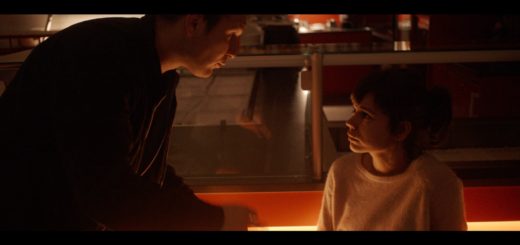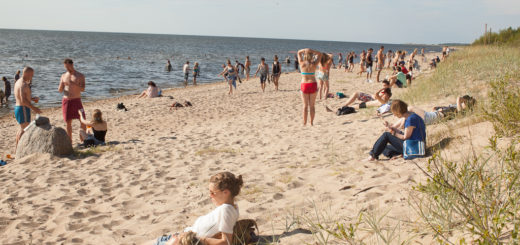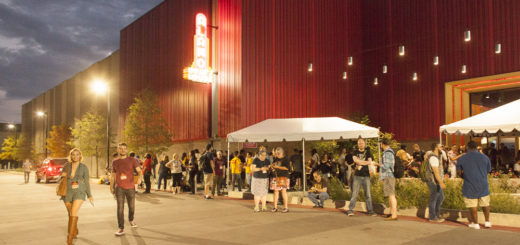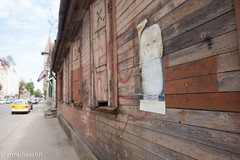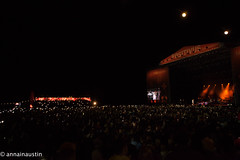Nashville Film Festival, Day Four
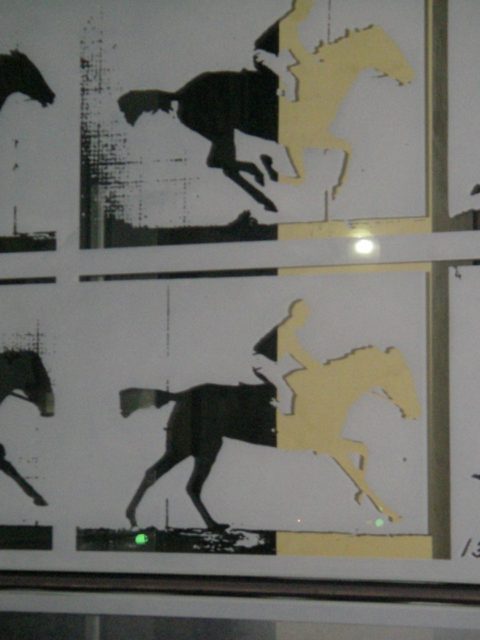
Image from the Harry Ransom Center, photo by Anna Hanks
via Our Man in Nashville, JASON T SPARKS
Sunday, May 12. This is not going to be the last day of the Nashville Film Festival, but it is going to be my last day; Tuesday, I’m leaving Nashville for about a week to take my son on a tour of a college in Wisconsin. Would I rather hang out here and keep watching movies? Part of me would, yes, but there are decidedly worse fates than a road trip with one’s incredibly cool oldest son.
This being my last day, I fill it to its theoretical rafters; today, I will take in five movies, more than any prior day. Four of them are good. Four of them have reasons to recommend them, four of them are worth your time, should they play near you, even if they’re flawed. The fifth, however…I’ll just go ahead and tell you that you are very likely to see the fifth. I know for a fact–and this is not always the case at festivals–that it is going to have a mass-market release. I also know–well, more accurately, I predict–it’s going to make terrific box office, but more importantly, it’s going to spark discussion. First, the four good movies…
The Good Documentary That I’m Not Entirely Sure We Needed. Christine Woodhouse’s One Vote was filmed entirely on a single day, one that will live in infamy, etc: November 8, 2016, our most recent Election Day. As the title would suggest, the film is about voting, and about various efforts across the country to cast votes, and to get other people to cast votes.
In Omaha, Nebraska, we follow trolley buses hired by Omaha’s most famous resident, Mr. Warren Buffet, as they roam the city in search of Omahans needing a ride to the polls; Warren himself rides one of the trolleys, and answers questions asked of him by the general public as if he were–well, as if he weren’t Warren Farkarkte Buffet, occasional Richest Man In The World (when Messrs Gates and Helu falter, that is). In rural Alaska, we watch Claude and Jennifer Bondy drive to their polling station, taking their son along and explaining the importance of voting to him–which sounds like watching paint dry, until you realize that “rural Alaska” makes rural anywhere else look like midtown Manhattan–their drive to the polls takes around eight hours, during which they have time to stop and hunt for elk. (Spoiler: the elk…does not make it to the polls. Well, he does, but he’s in no position to vote.)
In Chicago, we don’t watch a particular voter, but we are at a unique polling place–a polling tavern. That’s right, Chi-town boasts a bar and Italian restaurant in which it’s possible to vote; we spend the day with owner James Higgins as he guides voters and fixes drinks. In Kentucky, we watch what becomes the film’s most emotional story, as one Michael Hiser, a convicted felon who now serves as an addiction counselor, casting his first presidential vote since having his right to vote restored. There’s no question that Hiser, now a devoted dad and a beneficial member of his community, has reached a better season in his life; whether he’ll actually manage to jump the bureaucratic hoops between he and his vote is another matter.
All of which eventually serves to tell us…what? Voting is good, and we should do it? Sometimes it’s difficult to vote? Maybe I live in a bubble of sorts, but those aren’t surprising concepts in my world. Of course, there may be worlds where those are surprising concepts. If so, those worlds need this documentary. So, perhaps, we didn’t need it, if we means the privileged crowd at a film festival, but for any other we, it couldn’t hurt.
The Good Documentary That Doesn’t Necessarily Accomplish Its Stated Goal, But See It Anyway, Especially On A Big Screen, And Thus Remember Why We Go To Movies In The First Place. Neil Galinas is a documentarian who, for 88 minutes, takes us Into the Okavango. The Okavango is a river in Africa which flows through Angola, Botswana, and Namibia; surrounding it is the Okavango Delta, an unbelievably dense and diverse swath of flora and fauna–which swatch, according to researchers, is shrinking every year. To that end, National Geographic sent a team of researchers into the delta, hoping they would learn why the delta is in peril.
It cannot be denied that the team, led by scientists from around the world (including Angolan Adjany Costa, the most compelling “character”, if you will, in the film, who recounts the time she and her entire, extended family hid in a bathroom during the Angolan revolution), make voluminous discoveries in the delta; each scientist whose focus is a particular subset of the animal kingdom discovers multiple species hitherto unknown. Likewise, the local species discover them, especially the species known as Hippopotamus amphibius–The Okavango is home to vast numbers of hippo, one of whom, in the film’s most memorable sequence, glides up under one of the team’s boats, and capsizes it. We are treated to a POV version of this, from a camera that happened to be mounted (and running) on the boat in question.
What can be denied, however, is that a specific cause is ever determined for the Okavango’s decline; perhaps I was expecting someone in a pith helmet and jodhpurs to say, “AHA! The Okavango is dying because of Thing X!”–and perhaps I was unrealistic in that. The film will succeed, however, as a clarion call to environmental action, because it shows us how much life there is in the Okavango, and how unfathomably beautiful it can be. The snarky might call it “planet porn”–if you like perfectly lit, slow-motion footage of bull elephants charging through a field, you’re going to like this. And you owe it to yourself to see it on something other than a TV. (And you owe it to your planet to react to what you see.)
The Narrative Movie That Was Undeniably Well-Made, But Happened To Be About A Terrible Person. Susanna Nicchiarelli’s Nico, 1988 focuses on the last few years in the life of Christa Paffgen, AKA “Nico”, the singer made famous by Andy Warhol and his troupe. If you’re someone who has every Velvet Underground album, if you’re interested in the interplay between Nico, Warhol, Lou Reed, et alia, if your default mental picture of Nico is that of some winsome, haunting Manic Pixie Dream Girl, this movie is not for you. This movie occurs, as the title suggests, in 1988, which I must confess, I may have just now figured out: this movie is set in the year after Andy Warhol died. Nico, however, survives, and is attempting to tour Europe–including Eastern Europe, which was still an oppressive and difficult part of the world in 1988; she is also attempting to foster a relationship with her son Ari, who was taken from her custody during the Warhol years, but is now free to live with her.
If, however, actress Trine Dyrholm’s performance as Nico is accurate, and I have no reason to believe otherwise, Ari should run from Nico at all speed. The Nico depicted here is an acerbic, bitter harridan; she yells at her musicians, makes anti-Semitic comments to her long-suffering manager (John Gordon Sinclair), and sings like someone doing a bad Marlene Dietrich impression while actively having a stroke—and actively going through heroin withdrawal, as Nico often was. There’s no denying that the film is well-acted and beautifully shot—Eastern Europe looks wan and sickly, Southern Europe warm and nurturing—but the film does such a thorough job of depicting this woman’s cringe-inducing third act that we are at a loss for the answer to one question: why is it worth our time to know this?
The Narrative Film That Was More Or Less Exactly What I’d Been Hoping For, And As Such…Meh. Mickey Reece’s Alien is about Elvis, by which I mean Elvis himself (Jacob Snovel, doing a strong impression) is the main character, and the other characters include Priscilla, Col Tom Parker, and the various inner circles characters known collectively as the “Memphis Mafia”. The story, such as it is, posits that Elvis (and his stillborn twin brother, Jesse Garon), were in fact aliens born to Gladys (despite Gladys being human…it’s complicated, as the kids say). The King thus spends most of his life, or at least the parts of his life seen here, in search of something missing, unnamable, and baffling to those around him. As is often the case, it’s Serious Elvis played for laughs, and while the laughs do occur (particularly for Cate Jones, whose Priscilla is a master class in flat affect), there’s not much here you can’t already find in Mojo Nixon or early Ben Stiller.
The Narrative Film That Is Going To Be Huge And A Game-Changer and an Argument Starter and I Can’t Even With—and I Fell Bass-Ackwards Into Seeing For A Corny Reason.
I pursued the theatre in my youth; as such, I dig Broadway musicals—and I really dig those occasional moments when they are relevant again. As such, I’m one of those people (maybe you know some; maybe you are some) who is obsessed with the musical Hamilton. So, my ears pricked when I saw that one of the films at NFF this year featured a man named Daveed Diggs. Diggs has long been a member of Freestyle Love Supreme, the freestyle rap collective founded by Hamilton creator Lin-Manuel Miranda, and in the initial Broadway run of the Ten-Dollar Founding Father’s show, Diggs was a key member of the cast, pulling double duty as Marquis De Lafayette and Thomas Jefferson.
And, as I said, Diggs was (according to the promotional materials) also appearing in a movie at the NFF. The name of that movie is Blindspotting, and yes, Daveed appears in it—he’s the main character. He also wrote the screenplay, along with his co-star (and IRL friend since childhood), Rafael Casal. Diggs and Casal also produced the film; Carlos Lopez Estrada directed, but otherwise, it’s Daveed’s baby.
Perhaps because of the multiple roles he had in its production, a fragment of a thought came to mind as I watched: a black Citizen Kane. It’s also possible, however, that the fragment was the result of my being blown away by the film.
Blindspotting, filmed in Diggs’ hometown of Oakland, California, tells the story of Colin (Diggs), during the final three days of his parole; he’s been away for an unspecified crime (at first—flashbacks reveal what happened, and to give it away here would be a disservice). If he can go his final three days without re-offending, he’ll be a completely free man. Obviously, if there were no real risk of his re-offending, there would be no movie, and there is abundant risk. Most of the risk is connected to his friend Miles (Casal), who has known Colin since childhood, and is even more committed than Colin is to the hip-hop-laden world known as “thug life”, despite (or maybe because) Miles is Caucasian. (There is an ugly word often applied to folks like Miles, which word might also be used for, say, a manufacturer of wigs, or perhaps one who, if “wig” is being used as an adjective, is perhaps more “wig” than others.) Colin, being on parole, can have nothing to do with firearms; Miles seems to have a supply of them that borders on comical—until it doesn’t.
Another risk for Colin is something that has happened to his beloved Oakland during his time inside, something all too common in American cities: the ugly, if well-intentioned, specter of gentrification. The local drive-in fast-food place, likely a stand-in for Los Angeles’s iconic Fatburger, has started to offer veggie burgers. The corner store where Miles and Colin grab breakfast (and where Miles grabs his “square”, a single, unpackaged cigarette), has started to offer vile-looking green vegetarian drinks. These may not sound like horrifying changes, but the film shows us that they’re all part of a bigger picture: young, affluent, largely Caucasian groups discover a neighborhood—inevitably an older, working-class, ethnically diverse neighborhood—and begin to move in, to colonize. Their world, and the trappings thereof, begins to phase out the world and trappings of the old neighborhood. Colin and Miles work for a moving company; in a heart-rending scene, our heroes are sent to an old house, still full with the belongings (including wedding pictures) of the family who once lived there. They’ve been hired by the new owner, a house flipper whose single directive is to purge everything.
There’s another risk for Colin, a risk with the potential to be more than a risk to his parole. On the first of his final three nights, as he drives his moving van back to the halfway house where he’s serving his parole, he finds himself at a tragically-timed red light, and thus, he witnesses a white police officer shoot someone—someone who was running away from the police at the time. It’s nerve-wracking enough…and then Colin and the police officer, both in shock, make eye contact. Each has seen the other and knows it. The payoff is not immediate, but it looms over most of the movie, haunting it, haunting Colin. Until it doesn’t.
When Blindspotting is mass-released, as it is slated to be later this summer, mark my words: it’s going to spark discussion, controversy. Newspapers will carry op-ed pieces, and Diggs, in addition to reaching the celebrity stratosphere (possibly exceeding Mr. Miranda), will be invited to discuss/debate his film on news shows. There’s a lot here, a lot about gentrification, about race, about cultural appropriation, about law enforcement, about the connotations of another ugly word, perhaps the English language’s ugliest…and in the weeks since I’ve seen it, I’m still unpacking it all. I’ve been working to decide what Diggs is saying and what he isn’t, and whether I agree or not. Colin is given an incredible narrative in the story, forced as he is to negotiate the life he’s known and the world coming in all around him; what makes his story more complex (and better for it) is his relationship with Val (Janina Gavankar), an Indian-American who serves as the moving company’s dispatcher, and as Colin’s on-again off-again love interest. Val grew up in the old Oakland, but aspires to much of the new world as well—she’s impressed when Colin actually buys some of the green drink at the corner store. It’s Val, an aspiring psychology student, whose studies (and Colin’s assistance with same) give the film its title: “Blindspotting” is a mnemonic term Colin coins for the psychological phenomenon behind the two-faces-or-a-vase optical illusion, the one that calls our perceptions into question: what do we see, what don’t we see, and why?
And that, I must inform you with a heavy heart and a fatty liver, concludes my coverage of the Nashville Film Festival 2018. Thanks for coming on this journey with me. I have more journeys to come.
